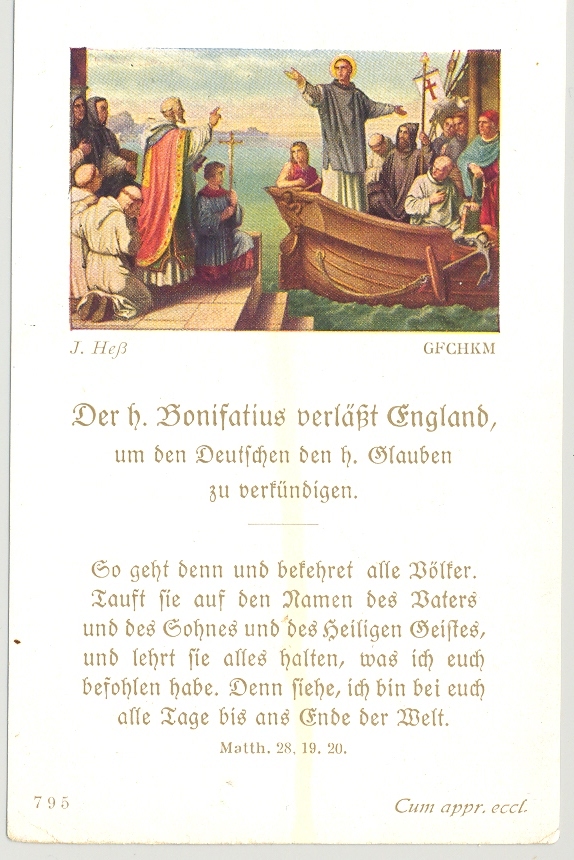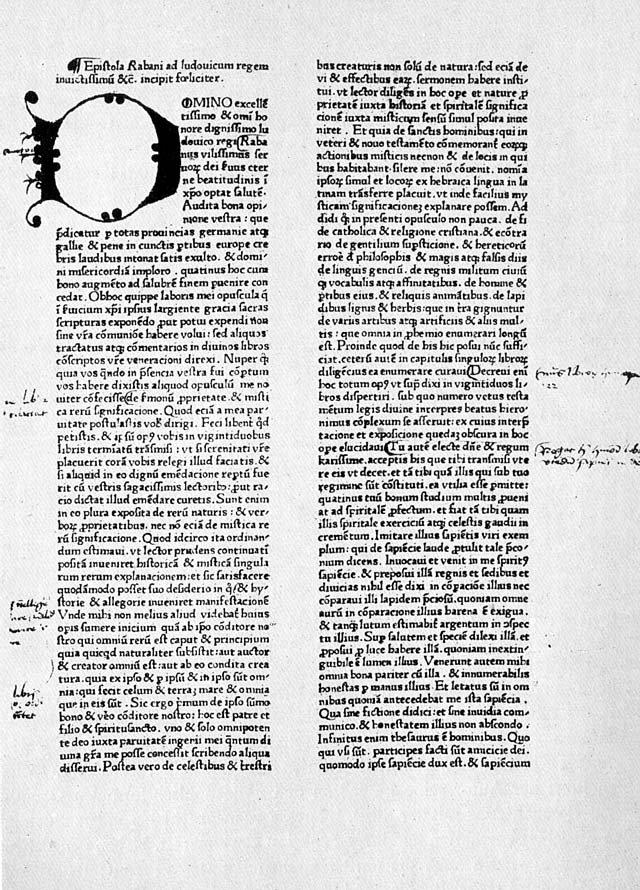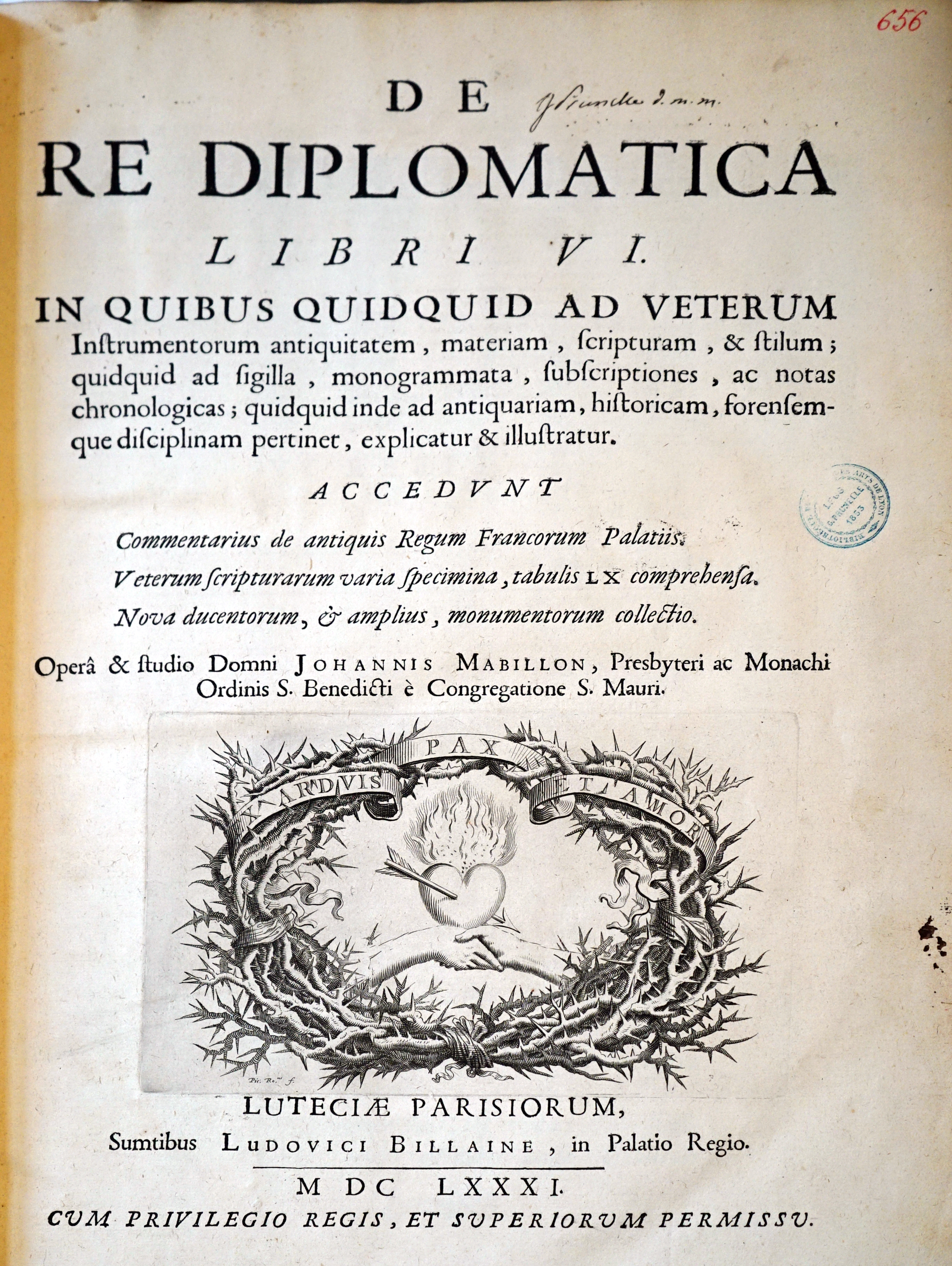|
Saint Solus
Saint Solus (also Sualo, Sola) (d. c. 790-794) was an English monk, in Germany with St. Boniface. Life Solus was from southern England. In 744, he went to the Monastery of Fulda where he was ordained priest by Saint Boniface, became a monk, and established himself in a cell at Solnhofen in Suabia. There he built an oratory, a small oratory on a site near a former Roman quarry, and worked as a missionary. In 793 Charlemagne visited Sola on his journey from Regensburg to the royal court in Weißenburg. The monk's reputation for holiness caused Charlemagne to make him a grant of the land where he had set up his hermitage. Solus then bestowed it as a cell on Fulda Abbey. He died about 790 and was buried at the northern outer wall of his church. His feast was celebrated on 3 December. Veneration A life of Solus was written in the ninth century by Ermanrich of Ellwangen, sometime between 836 and 842. He claimed to have derived his information from an old servant of the saint. It wa ... [...More Info...] [...Related Items...] OR: [Wikipedia] [Google] [Baidu] |
Saint
In Christianity, Christian belief, a saint is a person who is recognized as having an exceptional degree of sanctification in Christianity, holiness, imitation of God, likeness, or closeness to God in Christianity, God. However, the use of the term ''saint'' depends on the context and Christian denomination, denomination. In Anglican Communion, Anglican, Oriental Orthodox, and Lutheranism, Lutheran doctrine, all of their faithful deceased in Heaven are considered to be saints, but a selected few are considered worthy of greater honor or emulation. Official Ecclesiastical polity, ecclesiastical recognition, and veneration, is conferred on some denominational saints through the process of canonization in the Catholic Church or glorification in the Eastern Orthodox Church after their approval. In many Protestant denominations, and following from Pauline usage, ''saint'' refers broadly to any holy Christian, without special recognition or selection. While the English word ''saint'' ... [...More Info...] [...Related Items...] OR: [Wikipedia] [Google] [Baidu] |
Catholic Church
The Catholic Church (), also known as the Roman Catholic Church, is the List of Christian denominations by number of members, largest Christian church, with 1.27 to 1.41 billion baptized Catholics Catholic Church by country, worldwide as of 2025. It is among the world's oldest and largest international institutions and has played a prominent role in the history and development of Western civilization.Gerald O'Collins, O'Collins, p. v (preface). The church consists of 24 Catholic particular churches and liturgical rites#Churches, ''sui iuris'' (autonomous) churches, including the Latin Church and 23 Eastern Catholic Churches, which comprise almost 3,500 dioceses and Eparchy, eparchies List of Catholic dioceses (structured view), around the world, each overseen by one or more Bishops in the Catholic Church, bishops. The pope, who is the bishop of Rome, is the Papal supremacy, chief pastor of the church. The core beliefs of Catholicism are found in the Nicene Creed. The ... [...More Info...] [...Related Items...] OR: [Wikipedia] [Google] [Baidu] |
Princely Abbey Of Fulda
The Abbey of Fulda (; ), from 1221 the Princely Abbey of Fulda () and from 1752 the Prince-Bishopric of Fulda (), was a Benedictine abbey and ecclesiastical principality centered on Fulda, in the present-day German state of Hesse. The monastery was founded in 744 by Saint Sturm, a disciple of Saint Boniface. After Boniface was buried at Fulda, it became a prominent center of learning and culture in Germany, and a site of religious significance and pilgrimage through the 8th and 9th centuries. The ''Annals of Fulda'', one of the most important sources for the history of the Carolingian Empire in the 9th century, were written there. In 1221 the abbey was granted an imperial estate to rule and the abbots were thereafter princes of the Holy Roman Empire. In 1356, Emperor Charles IV bestowed the title "Archchancellor of the Empress" () on the prince-abbot. The growth in population around Fulda resulted in its elevation to a prince-bishopric in the second half of the 18th century. Alt ... [...More Info...] [...Related Items...] OR: [Wikipedia] [Google] [Baidu] |
Saint Boniface
Boniface, OSB (born Wynfreth; 675 –5 June 754) was an English Benedictines, Benedictine monk and leading figure in the Anglo-Saxon mission to the Germanic parts of Francia during the eighth century. He organised significant foundations of the Catholic Church in Germany, church in Germany and was made Elector of Mainz, Archbishop of Mainz by Pope Gregory III. He was martyred in Frisia in 754, along with 52 others, and his remains were returned to Fulda, where they rest in a sarcophagus which remains a site of Christian pilgrimage. Boniface's life and death as well as his work became widely known, there being a wealth of material available — a number of , especially the near-contemporary , legal documents, possibly some sermons, and above all his correspondence. He is venerated as a saint in the Christian church and became the patron saint of Germania, known as the "Apostle to the Germans". Norman Cantor notes the three roles Boniface played that made him "one of the truly ... [...More Info...] [...Related Items...] OR: [Wikipedia] [Google] [Baidu] |
Solnhofen
Solnhofen is a municipality in the district of Weißenburg-Gunzenhausen in the region of Middle Franconia in the ' of Bavaria in Germany. It is in the Altmühl valley. The local area is famous in geology and palaeontology for Solnhofen limestone. This is a very fine-grained limestone from the Jurassic period Lagerstätte that preserves detailed fossil specimens. Alois Senefelder used specially prepared blocks of the fine Solnhofen limestone for the process of lithography which he invented in 1798. The quarrying of this lithographic limestone subsequently yielded spectacular finds, including '' Archaeopteryx'', commemorated in the bird's full name ''Archaeopteryx lithographica''. All 13 known specimens have come from the Solnhofen area. Geography Solnhofen is located on the Altmühl in Bavaria. It contains two districts: Hochholz and Eßlingen. It is adjacent to the municipalities Pappenheim, Langenaltheim, and Mörnsheim. History Solnhofen was known as "Husen" in th ... [...More Info...] [...Related Items...] OR: [Wikipedia] [Google] [Baidu] |
Suabia
Swabia ; , colloquially ''Schwabenland'' or ''Ländle''; archaic English also Suabia or Svebia is a cultural, historic and linguistic region in southwestern Germany. The name is ultimately derived from the medieval Duchy of Swabia, one of the German stem duchies, representing the historic settlement area of the Germanic tribe alliances named Alemanni and Suebi. This territory would include all of the Alemannic German area, but the modern concept of Swabia is more restricted, due to the collapse of the duchy of Swabia in the thirteenth century. Swabia as understood in modern ethnography roughly coincides with the Swabian Circle of the Holy Roman Empire as it stood during the early modern period, now divided between the states of Bavaria and Baden-Württemberg. Swabians (''Schwaben'', singular ''Schwabe'') are the natives of Swabia and speakers of Swabian German. Their number was estimated at close to 0.8 million by SIL Ethnologue as of 2006, compared to a total population ... [...More Info...] [...Related Items...] OR: [Wikipedia] [Google] [Baidu] |
Charlemagne
Charlemagne ( ; 2 April 748 – 28 January 814) was List of Frankish kings, King of the Franks from 768, List of kings of the Lombards, King of the Lombards from 774, and Holy Roman Emperor, Emperor of what is now known as the Carolingian Empire from 800, holding these titles until his death in 814. He united most of Western Europe, Western and Central Europe, and was the first recognised emperor to rule from the west after the fall of the Western Roman Empire approximately three centuries earlier. Charlemagne's reign was marked by political and social changes that had lasting influence on Europe throughout the Middle Ages. A member of the Frankish Carolingian dynasty, Charlemagne was the eldest son of Pepin the Short and Bertrada of Laon. With his brother, Carloman I, he became king of the Franks in 768 following Pepin's death and became the sole ruler three years later. Charlemagne continued his father's policy of protecting the papacy and became its chief defender, remo ... [...More Info...] [...Related Items...] OR: [Wikipedia] [Google] [Baidu] |
Ermanrich Of Passau
Ermanrich or Ermenrich (Hermanrich; born c. 814 – 874) was a Benedictine monk and court chaplain, who became Bishop of Passau from 866 to 874. He supported East Francia's expansion to the east, and likewise the expansion of the eastern bishoprics, and opposed the missionary efforts of Cyril and Methodius, who he considered intruders. This brought him into conflict with the Papacy, which supported the brother missionaries. Life Ermenrich, son of a Swabian noble family, was originally a Benedictine monk at Ellwangen Abbey. At the Monastery of Fulda he was a student of Rabanus Maurus and Rudolf von Fulda. At the court of Louis the German, Ermanrich was one of Archchaplain Gozbald's students. He became a member of the Hofkapelle, and as a court chaplain was closely connected with Abbot Grimald, in whose monastery he lived temporarily. Ermenrich enjoyed great respect both as a scholar and as a writer. In the early 840's, at the request of Gundram, court chaplain to Louis the Pious ... [...More Info...] [...Related Items...] OR: [Wikipedia] [Google] [Baidu] |
Louis The Pious
Louis the Pious (; ; ; 16 April 778 – 20 June 840), also called the Fair and the Debonaire, was King of the Franks and Holy Roman Emperor, co-emperor with his father, Charlemagne, from 813. He was also King of Aquitaine from 781. As the only surviving son of Charlemagne and Hildegard (queen), Hildegard, he became the sole ruler of the Franks after his father's death in 814, a position that he held until his death except from November 833 to March 834, when he was deposed. During his reign in Aquitaine, Louis was charged with the defence of the empire's southwestern frontier. He Siege of Barcelona (801), conquered Barcelona from the Emirate of Córdoba in 801 and asserted Frankish authority over Pamplona and the Basques south of the Pyrenees in 812. As emperor, he included his adult sons, Lothair I, Lothair, Pepin I of Aquitaine, Pepin and Louis the German, Louis, in the government and sought to establish a suitable division of the realm among them. The first decade of his reig ... [...More Info...] [...Related Items...] OR: [Wikipedia] [Google] [Baidu] |
Rabanus Maurus
Rabanus Maurus Magnentius ( 780 – 4 February 856), also known as Hrabanus or Rhabanus, was a Frankish Benedictine monk, theologian, poet, encyclopedist and military writer who became archbishop of Mainz in East Francia. He was the author of the encyclopaedia ''De rerum naturis'' (''"On the Natures of Things"''). He also wrote treatises on education and grammar and commentaries on the Bible. He was one of the most prominent teachers and writers of the Carolingian age, and was called "Praeceptor Germaniae", or "the teacher of Germany". In the most recent edition of the Roman Martyrology ('' Martyrologium Romanum'', 2004, pp. 133), his feast is given as 4 February and he is qualified as a Saint ('sanctus'). Life Rabanus was born of noble parents in Mainz. The date of his birth remains uncertain, but in 801 he was ordained a deacon at Benedictine Abbey of Fulda in Hesse, where he had been sent to school and had become a monk. At the insistence of Ratgar, his abbot, he wen ... [...More Info...] [...Related Items...] OR: [Wikipedia] [Google] [Baidu] |
Luc D'Achery
Luc d'Achery (1609 – 29 April 1685) was a learned France, French Benedictine of the Congregation of St. Maur, a specialist in the study and publication of medieval manuscripts. Life D'Achery was born at Saint-Quentin, Aisne, Saint Quentin in Picardy. He entered the Order of St. Benedict at an early age and was professed at the Trinity Abbey, Vendôme, on 4 October 1632, but his health soon obliged him to remove to Paris. He became a member of the monastery of St. Germain des Prés in 1637, which in nearly fifty years he scarcely ever left, and he died there aged about 75. As librarian of the monastery he was soon acquainted with its rich treasures of medieval history and theology. By a continuous correspondence with other monasteries, both in and out of France, he made himself a bibliographical authority of the first rank, especially in all that pertained to the unedited or forgotten writings of medieval scholars. Works His first important work was an edition (Paris, 1645) ... [...More Info...] [...Related Items...] OR: [Wikipedia] [Google] [Baidu] |
Jean Mabillon
Dom Jean Mabillon , (; 23 November 1632 – 27 December 1707) was a French Benedictine monk and scholar of the Congregation of Saint Maur. He is considered the founder of the disciplines of palaeography and diplomatics. Early life Mabillon was born in the town of Saint-Pierremont, then in the ancient Province of Champagne, now a part of the Department of Ardennes. He was the son of Estienne Mabillon and his wife Jeanne Guérin. At the age of 12 he became a pupil at the Collège des Bons Enfants in Reims. Having entered the seminary in 1650, he left after three years and in 1653 became instead a monk in the Maurist Abbey of Saint-Remi. There his dedication to his studies left him ill, and in 1658 he was sent to Corbie Abbey to regain his strength. He was ordained at Corbie in 1660. In 1663 he was transferred again to Saint-Denis Abbey near Paris, and the following year to the Abbey of Saint-Germain-des-Prés in Paris. This was a move which offered wide opportunities f ... [...More Info...] [...Related Items...] OR: [Wikipedia] [Google] [Baidu] |






